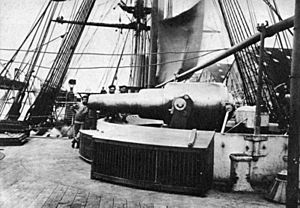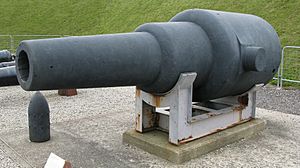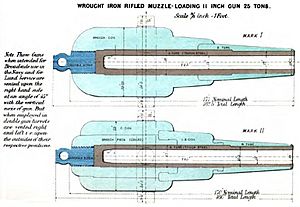RML 11-inch 25-ton gun facts for kids
Quick facts for kids Ordnance RML 11-inch 25-ton gun |
|
|---|---|

Disappearing gun on HMS Temeraire in firing position
|
|
| Type | Naval gun Coast defence gun |
| Service history | |
| In service | 1867–1903 |
| Used by | Royal Navy |
| Wars | Bombardment of Alexandria |
| Production history | |
| Manufacturer | Royal Arsenal |
| Unit cost | £1,589 (18751) |
| Variants | Mk I, Mk II |
| Specifications | |
| Mass | 25 long tons (25,000 kg) |
| Barrel length | 145 inches (3.7 m) (bore + chamber) |
|
|
|
| Shell | 532 to 543 pounds (241.3 to 246.3 kg) Palliser, Common, Shrapnel |
| Calibre | 11-inch (279.4 mm) |
| Muzzle velocity | 1,360 feet per second (410 m/s) |
The RML 11-inch 25-ton gun was a huge cannon used a long time ago. It was a main weapon on big British warships and also protected coastlines. These guns were called "rifled muzzle-loaders." This means you loaded them from the front (muzzle), and they had spiral grooves inside (rifling) to make the shells spin. This spinning made the shells fly straighter and farther.
This 11-inch gun was very similar to the RML 12-inch 25-ton gun. The only real difference was that its barrel was made 11 inches wide instead of 12 inches.
Contents
How the Gun Was Designed
The first version of this gun, called Mark I, was made in 1867. A few years later, in 1871, a new version called Mark II came out.
The Mark II used a simpler and cheaper way to build the gun. This new method, called "Fraser" gun construction, had worked well for other cannons like the RML 9-inch 12-ton Mk IV gun.
Where These Guns Were Used
These powerful guns were put on large British warships. Two famous ships that carried them were:
- HMS Alexandra, which started service in 1877.
- HMS Temeraire, which also started service in 1877.
The guns were also used to defend coastlines. They helped protect important areas from enemy ships. One famous battle where these guns were used was the Bombardment of Alexandria in 1882.
What the Guns Fired
When these guns were first made, their shells had special "studs" (small bumps) on them. These studs fit into the spiral grooves inside the gun's barrel, making the shell spin as it flew out.
Later, new inventions helped make the shells even better. "Attached gas-checks" were added to the shells. These helped reduce wear on the gun and made the shells fly farther and more accurately. Even newer "automatic gas-checks" were developed. These allowed the guns to fire shells without studs, which was a big improvement.
The main type of shell fired was the "Palliser" armour-piercing shot. These heavy shells weighed about 536 to 543 pounds. They were designed to punch through enemy ship armor. To give them maximum power, they were fired with a large amount of gunpowder, called a "Battering charge."
The guns could also fire other types of shells:
- Shrapnel shells weighed about 532 to 536 pounds. These shells exploded in the air and sent out many small pieces, like a giant shotgun blast.
- Common shells also weighed about 532 to 536 pounds. These were explosive shells designed to cause damage by bursting on impact.
These shells were fired with a "Full charge" of gunpowder, which was a bit less than the "Battering charge" used for the armor-piercing shells.
Where to See Them Today
You can still see some of these historic guns in different places around the world. They are a reminder of how powerful weapons were made in the past.


- Two Mark II guns (numbers 12 and 14) are at Fort George, Bermuda.
- A Mark II gun (number 30) is at Fort Nelson, Portsmouth, UK.
- Three Mark II guns are on Drake's Island, Plymouth, UK.
- Four guns can be seen outside Fort Saint Elmo, Malta.
- A Mark II gun from 1871 is outside Fort St. Catherine, Bermuda.


